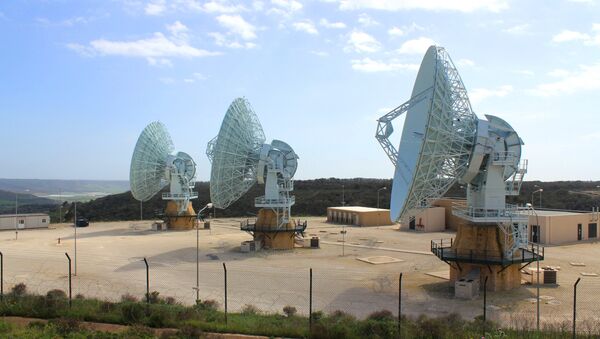At the US Navy base in Niscemi, Sicily, one of the world's most sophisticated military communications systems stands. Three giant satellite dishes sit on top of a hill, reminding locals of the unwanted US military presence.
Over the last decade, the US has made huge investments in a complex satellite system called 'Mobile User Object Systems' (MUOS). The purpose is to allow American soldiers anywhere in the world to access encrypted cell phone data that can receive sensitive information related to military matters. The beauty of the device is that it will transmit information via 3G, so there is no need for a cellphone tower nearby.
The US Navy wanted to introduce the system to make communications faster, and more secretive.
The MUOS system is made of four ground bases around the world, which are linked to satellites. Ground bases are located in Hawaii, Virginia, Australia, and in Southern Sicily.
Seven Years in the Making
The US places special strategic value on its base in Sicily, and for an obvious reason; it allows them to monitor ongoing situations in an area of particular interest — the Middle East.
Overall, the Navy has spent seven years working on the facility, and the US is now ready to flick the switch and make the base operational.
However, in the nearby town of Niscemi, which houses nearly 30,000 people, locals have decided they don't want to live with the electromagnetic fields generated by the satellite antennas.
Protests against the base are not a new development. They began as soon as the navy started building several years ago. Local campaigners against the base have taken it all the way to the courtrooms, now meaning that the US cannot use the MUOS facility until it's given the green light by the Italian judiciary.
"Initially, the US Navy and the Italian Ministry of Defense tried to ignore the inconvenient truth that the base was upsetting the locals," says professor Massimo Corradi, a leading campaigner against the base.
"However now our campaign has taken them to the courts, they have to at least listen to our grievances."
Headaches, Sickness and Brain Cancer
The main defender of the base has been the Ministry of Defense, who has tried to guarantee the US Navy a safe place to set up camp. The main accuser is a group of organizations, led by the No-MUOS committee, who has built a case against the base on grounds that it is poses serious health risks. The campaigners fear that the electromagnetic emissions will increase the risk of cancer to locals.
Professor Massimo Zucchetti, a nuclear energy expert, conducted an independent study with Corradi into whether the concerns about the base were legitimate. In conclusion, they found that if activated, the base would pose a danger to the health of the local population:
"We found that many people have complaints about suffering with headaches and sickness, especially those living close to the base," Zucchetti told Sputnik.
If that's not enough to demonstrate the risks of the base, Corradi also told Sputnik that "there is strong evidence to suggest that prolonged exposure to such electromagnetic fields can, and in some cases we are sure, has been linked to diseases such as brain cancer."
To combat these claims, the US charged Dr John Oetting with an independent assessment of the risks of exposure. Mr Oetting also happens to be the base's project manager and lead system engineer. He concluded that a person living near it is "exposed to less energy than someone making a give-minute cell phone call or cooking with a microwave."
Italians understandably have questioned the reports reliability, given that its written by someone involved with the MUOS.
"Why should we trust a report that's clearly partisan, and we know that the US will probably distort facts to get its way," said Francesca Nicolo, a local activist with the No-MUOS campaign.
Construction Not Allowed
Despite local protest and research criticizing the possible dangers, the lack of agreement and long-term studies have made it difficult to come to a conclusion.
To make matters worse, the Italian court ordered another study into the issue, assigning five experts, three of them being government ministers.
The Ministry of Defense has recently agreed to make a compensation payout of around US$4.6 million to Niscemi for constructing the MUOS ground station. It was said that the money would be used to build a new cancer ward at the local hospital, however so far no work has been done.
The next court verdict is expected some time soon, yet it looks unlikely that the battle will end there.
"We are sure that the US won't give up, but neither will we, the health of our community is too important to give up on. We won't let them push us around," said Nicolo.
For now the question remains: will the US prioritize its military interests or seriously listen to the concerns of Niscemi's people?




